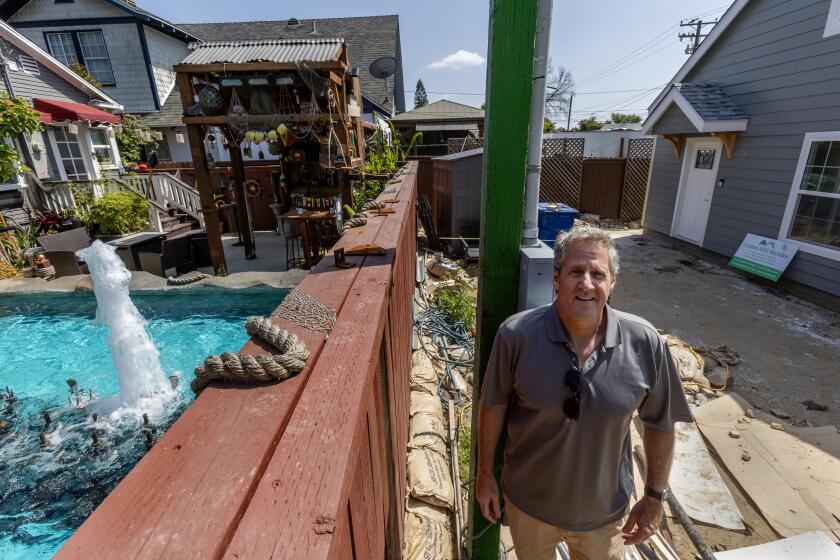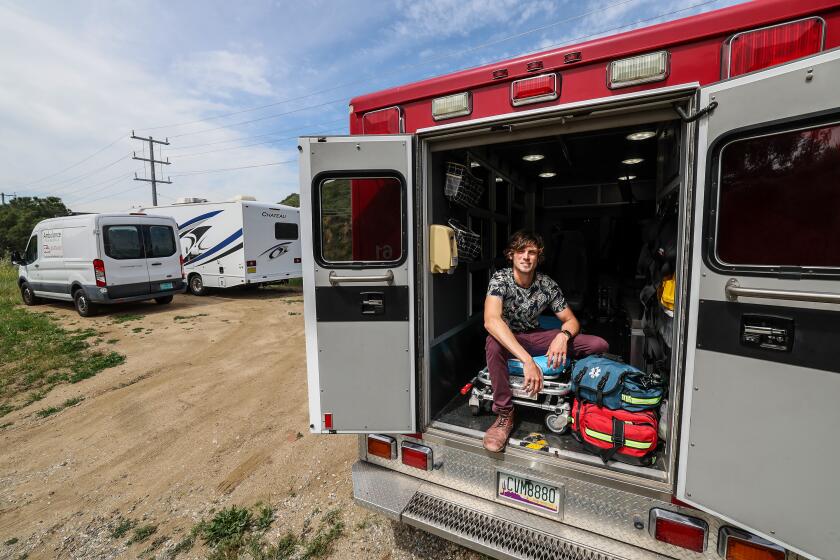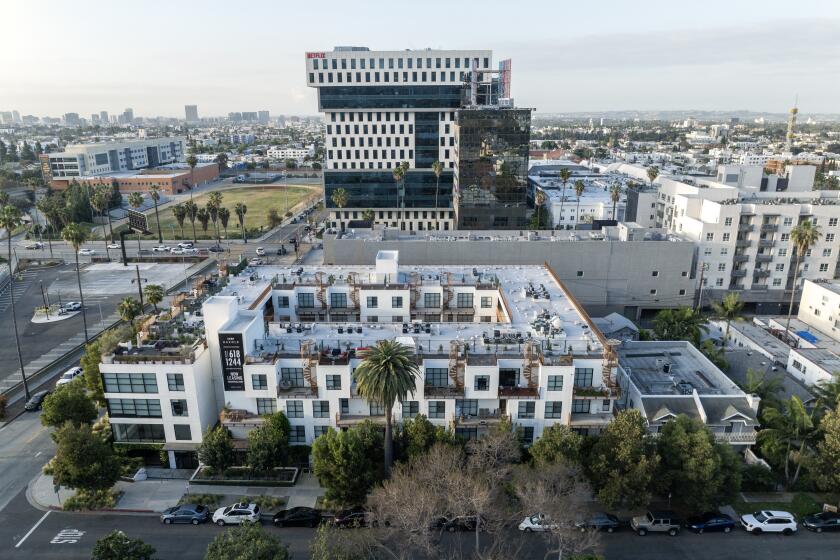Undone by their dreams
First of two parts
Dirt is cheap in the Victor Valley, and amid tumbleweeds and rabbit brush, Joshua trees and juniper bushes, home developments rise up like islands where the desert has been rolled back.
About 300,000 people call this region home. Baked in the summer, frozen in winter, it is scoured by winds that sweep down the mountains — and yet they come, drawn by what they can’t find elsewhere in Southern California: the promise of large and affordable houses in clean and safe neighborhoods.
In 2006, Dawn and Michael Meenan found what they were looking for in Hesperia, in a community called Mission Crest. But they had declared bankruptcy four years earlier and were uncertain they could buy a house here. Then the phone rang.
“Your loan has been approved.”
They had selected their lot, paid their deposit, and Parcel No. 3046-311-27-0000 was theirs. It wasn’t much to speak of — a dip in the curb where their driveway would be and the hard-packed soil beyond — but in a few months it would be their first home: four bedrooms, two baths and a den.
On the summer day the Meenans moved in, their children traced angel wings in the plush carpet. There were no homes behind theirs, just empty lots, and the procession of framing crews, electricians, plumbers and drywallers was constant. In the first few months, they repaired at least 10 flat tires and watched this suburb come together.
On one Halloween their children went trick-or-treating, dressed as a pumpkin, Tinker Bell and Dale Earnhardt Jr., and Dawn and Michael met their neighbors. For birthday parties, they rented an inflatable bouncer and organized carnival games. They staged a luau in winter, Christmas lights still on the eaves.
Then the housing bubble burst, and the recession kicked in.
Construction stopped when a builder filed for bankruptcy in April 2008, leaving nearly 100 graded lots bare and six Craftsman-style houses ready for roofing and stuccoing that never happened. A sign advertising home sites stayed up even after the phone number was reassigned.
Foreclosures started to sweep through the community, creating a patchwork of disrepair. For Sale signs dotted the streets. Vandals targeted empty homes. Boarded-up windows and weed-choked yards detracted from well-maintained houses with tile roofs, recessed entries and stone and brick detailing.
In the last four years, according to the San Bernardino County assessor’s office, 373 of the 941 single-family homes in Mission Crest — nearly 40% — have been foreclosed on. Thirty-five have gone through foreclosure more than once. Properties that once sold for nearly $400,000 are worth less than $200,000.
Today homeowners pass along anxious stories about their community — churches set up in garages, houses turned into rentals, gangs moving in, subsidized housing taking over blocks — without knowing what is true and what isn’t.
Little did the Meenans know that their dreams would lead to disappointment and their refuge would be so fleeting.
Dreams in the dirt
Most Angelenos know the High Desert as a blur of billboards just beyond the Cajon Pass, 75 miles from downtown Los Angeles, the start of the Mojave, that lengthy inconvenience en route to Las Vegas.
Speculators and retirees put the region on the map in the 1950s, and when Michel Dunia heard President Eisenhower talk to the nation about an interstate highway system, he saw opportunity.
Dunia wasn’t unique in his ambition to own land in the desert, but where others dreamed big, he dreamed shrewdly. One day the Lebanese immigrant hired a pilot and a biplane and charted the most likely route for the 10 and the 15 freeways. His explorations took him over the Cajon Pass, where he began to buy parcels of dirt, one of which would become Mission Crest.
At first his investments sat fallow, but Dunia was a patient man. He knew that growth in Southern California would someday reach the region. Escalating home prices helped, and in 1990 Dunia sold 240 acres in Hesperia to Homestead Land Development Co., which mapped 942 home sites. At the time, the desert was booming.
But prosperity washes over the desert in waves, and Homestead soon foundered. The closing of George Air Force Base, 14 miles to the north, cast a 10-year shadow over the region, and the Homestead property changed hands a number of times until Empire Land Co. picked it up in 2004.
Empire Land, based in Ontario, was a meteor among land development companies. Before filing for bankruptcy two years ago, it had broad ambitions for the West. Formed in 2002 by James Previti after the sale of his home-building company for $240 million, Empire soon acquired properties in Arizona and the High Desert.
When Empire Land presented its plan to develop the Homestead site, the company found a sympathetic audience among city officials. The boom years had returned to the High Desert, and concerns that the development was too crowded, that there wasn’t enough water and that the community tax would be too high to sustain a resale market were overcome. In August 2004, the planning commission approved a subdivision of 1,039 homes.
As the bulldozers began leveling the desert, more than 400 Joshua trees, the symbol on the city’s seal, were uprooted and relocated.
Hearing a ‘yes’
Dawn and Michael Meenan first explored Hesperia on Thanksgiving weekend in 2005. They pulled off Interstate 15 onto Main Street. Builders’ flags and banners snapped in the cold wind. Their three children sat in the back watching “Caillou.”
They followed the signs and billboards to the subdivision, set off from the desert by a cinder-block wall. Six builders were showing model homes. A large red balloon soaring above one tract tugged at its anchor.
For the next few months, on Sundays after breakfast, the Meenans would leave their rental in West Covina and head to the High Desert. Amid the imposing two-story designs, they settled on a modest single-story home — yet with 2,400 square feet, it was large enough for their growing family. The sales representatives told them that one would be available on Newport Street by midsummer, and if they put down a $3,000 deposit they could lock in the price at $365,000.
They could barely scrape together the deposit, and they didn’t have a down payment for the mortgage. The sales representatives didn’t seem worried. Let’s see what we can do, they said, giving the Meenan children crayons to color with and taking notes on the couple’s credit history.
Countrywide Financial Corp. turned them down. Freedom Plus Mortgage said yes. After signing the loan documents, the Meenans worried they would be overextended, but they told themselves that this was what first-time homebuyers do, especially when they’re in their 30s and their family is young.
To save money for the closing costs, they moved in with Dawn’s parents, said no to nearly every upgrade (they had to have a microwave) and watched with happiness as their home was built. They took photos and videos. They saved the letters the sales representatives sent them.
“Welcome to this big wide wonderful world,” one of them wrote to the couple’s fourth child, born that summer. “And welcome to your brand new first home.... We look forward to meeting you. Tell your parents ‘Congratulations’ for me. We’ll see you soon.”
The Meenans were soon joined by more than 900 families. With cul-de-sacs, a park, a new school and the promise of a nearby Wal-Mart and Home Depot, Mission Crest seemed luxurious and family-friendly, just like the more expensive communities in Valencia and Irvine.
Worth the sacrifice
Given their bankruptcy, the Meenans qualified only for a subprime mortgage. Their first loan was fixed at 7.375% for three years and was then adjustable; their second was fixed at 11.625% for 30 years. The payments came to more than $2,500 a month.
Both loans were two percentage points above market rates, and in 2036 they would have to make balloon payments totaling nearly $300,000. Then there were the property and the community taxes — nearly $3,000 twice a year.
But they managed. When Dawn’s maternity leave was over, she went back to work as a bookkeeper for an Irwindale-based online company that sells vitamin supplements. Michael worked in the firm’s warehouse. Together they made nearly $95,000 a year.
Every weekday morning at 6:30, the family would get into the minivan and head over the Cajon Pass. The commute was a little more than an hour. Dawn would drop Michael off to start his shift, and she would take the three children and the baby to her parents’ house in Arcadia before going to the office. At the end of the day, Michael picked up the children and returned to Irwindale to get Dawn. Then they would all head back to Hesperia for dinner, baths, TV and story time.
If it was a sacrifice, they told themselves, it was worthwhile. They were building equity. They were improving their credit scores. In time, their income would rise, and they could refinance. That was what the sales representatives had told them.
In March 2007, Michael was laid off and had to take odd jobs. Three months later, Dawn’s employer gave her a chance to start her own bookkeeping business. She could work at home, and as she brought in clients, the family income climbed back to near six figures. She and Michael felt secure enough to landscape the backyard, put in a patio and plant a vegetable garden.
The idyll proved brief. As the recession deepened, Dawn lost clients, and their income started to fall. In December 2008, they did not pay their property tax. They didn’t have the money. Besides, they rationalized, homes in the area had dropped almost $200,000 in value, and they’d be getting a reassessment and their taxes should go down.
Then one day, as Dawn organized the bills, she saw how fast they were falling behind. She was paying the mortgage later each month, and in July the interest rate on the first loan would reset upward. It could cost them anywhere from $100 to $1,000 more each month.
“I don’t know what we’ll do,” she said to Michael.
They spoke to the bank but were told that they didn’t qualify for a loan modification, and in May they just couldn’t pay the mortgage anymore. Sad and angry, they stopped paying on the first loan — then, two months later, on the second.
They contacted a real estate agent to list the house. They waited until after Michael’s birthday in August to put up the For Sale sign. They didn’t want to have to explain the situation to their family just yet.
In October, the house was sold for $125,000. As the family waited in the car, Michael went inside for one last look. The sunlight streaming through the windows looked different without the curtains, but it still brought back a flood of memories. When he saw the stain on the carpet from one of the children’s spilled drinks, he cried.
“We felt guilty,” said Dawn, sitting in the living room of the home they currently rent, less than two miles away. “We had a responsibility to pay for our house. Walking away was hard to accept.”
In less than three years, as the housing market stalled and home prices fell, the Meenans watched neighbors give up their dreams and the community hollow out. Some left because they had to, others because staying no longer made sense.
Monday: As a community unravels, hope lives on in a boardinghouse.
On the Web: An extended photo gallery can be found at latimes.com/missioncrest




